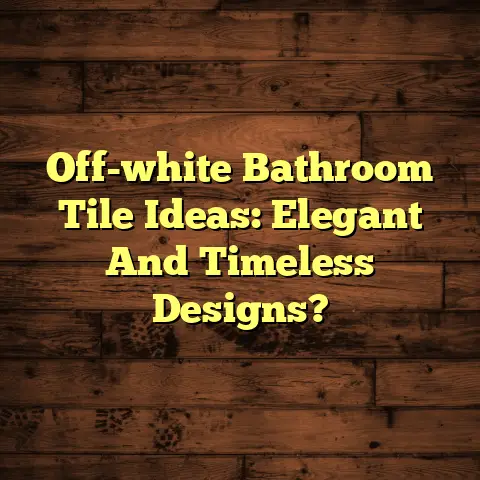Transitioning Wood Floors (1 Pro Avoids This!)
I’ve seen it all, from DIY disasters to breathtaking transformations.
Today, we’re diving deep into the world of wood floor transitions – those often-overlooked details that can make or break a flooring project.
And I’m going to let you in on a little secret: there’s one transition method I actively avoid, and I’ll tell you why.
But first, let’s talk about something exciting that’s been shaking up the flooring industry: engineered wood flooring.
Think of it as hardwood’s cooler, more adaptable cousin.
It boasts a real wood veneer over a core of plywood or high-density fiberboard (HDF).
This construction makes it more resistant to moisture and temperature changes than solid hardwood.
Meaning less warping and buckling – a huge plus for areas with fluctuating humidity.
Plus, it’s often more budget-friendly and comes in a wider variety of styles and finishes.
According to a report by Grand View Research, the global engineered wood flooring market is expected to reach $47.5 billion by 2027.
That’s a lot of love for engineered wood!
It’s a testament to its durability, versatility, and, let’s face it, its gorgeous looks.
Ready to become a flooring transitions pro? Let’s jump in!
Understanding Wood Floor Transitions
So, what exactly are flooring transitions?
Simply put, they’re the bridges between different flooring materials or different levels within your home.
Think of them as the unsung heroes that create a smooth, safe, and visually appealing flow from one space to another.
Without them, you’re looking at potential tripping hazards, unsightly gaps, and even structural damage down the line.
There are several types of transitions commonly used:
-
T-Molding: This is your go-to for joining two floors of the same height. It’s shaped like a “T” and sits flush with both surfaces.
-
Reducers: These are used when you have a slight height difference between two floors. They slope gently from the higher floor to the lower one.
-
Thresholds: These are perfect for doorways or areas where the flooring meets a different material like tile or carpet.
-
End Caps: These are used to create a finished edge where the wood flooring meets a vertical surface, like a wall or a sliding glass door track.
Why are transitions so important?
Well, for starters, they prevent tripping.
Imagine walking from a hardwood floor onto a much thicker tile floor without a reducer. Ouch!
Wood naturally expands and contracts with changes in humidity.
Transitions allow for this movement without causing the floors to buckle or crack.
And let’s not forget aesthetics.
A well-chosen transition can seamlessly blend different flooring types, creating a cohesive and polished look throughout your home.
The Common Challenges in Transitioning Wood Floors
Now, let’s talk about the pitfalls.
Transitioning wood floors isn’t always a walk in the park.
I’ve seen homeowners struggle with a variety of issues, and I want you to avoid these headaches.
One of the most common problems is height differences.
If one floor is significantly higher than the other, you’ll need to find a transition that can accommodate that difference without creating a tripping hazard.
Expansion gaps are another tricky area.
Failing to leave enough space for the wood to expand can lead to buckling and cracking, especially in areas with high humidity.
And then there’s the aesthetic mismatch.
Choosing a transition that clashes with the surrounding flooring can ruin the entire look of the room.
I’ve seen it happen.
Imagine a beautiful, rustic hardwood floor paired with a shiny, modern metal transition. Yikes!
Improper transitions can lead to some serious problems.
Tripping hazards are a safety concern, especially for families with young children or elderly members.
Moisture damage can occur if the transition doesn’t properly seal the gap between the floors, allowing water to seep underneath.
And let’s not forget the visual discord.
A poorly chosen or installed transition can detract from the overall beauty of your home, making it look unfinished and unprofessional.
Professional Insights on Transitioning Techniques
Alright, let’s get to the good stuff.
I’m going to share some insights from my years of experience in the flooring business.
Specifically, I want to talk about one transition method that I actively avoid: using a flush stair nose between a wood floor and tile.
Now, you might be thinking, “What’s wrong with a flush stair nose?”
On the surface, it seems like a clean and modern solution.
However, in my experience, it often leads to more problems than it solves.
The main issue is the lack of adequate support and the increased risk of cracking.
Flush stair noses are designed to sit flush with the top of the adjacent flooring material.
When used between wood and tile, especially with the thinset mortar used for tile installation, it can create a weak point.
Here’s why I think it’s not worth the risk:
-
Cost: While the stair nose itself might not be expensive, the labor involved in precisely cutting and fitting it can add up. Plus, if it cracks or breaks, you’re looking at costly repairs.
-
Time: Installing a flush stair nose requires meticulous attention to detail and precise cuts. It’s a time-consuming process that can easily go wrong if you’re not careful.
-
Aesthetic Concerns: Even when installed perfectly, a flush stair nose can sometimes look out of place, especially if the wood and tile have different thicknesses or textures.
I’ve seen too many flush stair noses crack or become loose over time.
The constant foot traffic and the slight movement of the wood floor can put stress on the transition, eventually leading to failure.
Instead, I prefer using a more robust and forgiving transition method, such as a standard overlap stair nose or a custom-fabricated metal transition.
These options provide better support and are less likely to crack or become loose.
Detailed Steps for Effective Wood Floor Transitions
Okay, let’s get practical.
I’m going to walk you through the steps for a successful wood floor transition, incorporating my preferred methods and the lessons I’ve learned over the years.
For this example, let’s say we’re transitioning from a ¾-inch engineered wood floor to a slightly thicker tile floor in a doorway.
Here’s what you’ll need:
-
Transition Molding (Reducer): Choose a reducer that complements your flooring and can accommodate the height difference.
-
Measuring Tape: Accuracy is key!
-
Pencil: For marking your cuts.
-
Miter Saw: For making precise cuts.
-
Construction Adhesive: To secure the transition to the subfloor.
-
Drill and Screws (Optional): For added stability.
-
Safety Glasses and Hearing Protection: Safety first!
Step 1: Measure and Plan
Carefully measure the width of the doorway where you’ll be installing the transition.
Mark the measurement on your transition molding.
Take your time and double-check your measurements.
A mistake here can throw off the entire installation.
Step 2: Cut the Molding
Using your miter saw, carefully cut the transition molding to the correct length.
Make sure the cut is clean and straight.
A slightly angled cut can create an unsightly gap.
Step 3: Prepare the Subfloor
Clean the subfloor where the transition will be installed.
Remove any debris, dust, or old adhesive.
A clean surface will ensure a strong bond between the transition and the subfloor.
Step 4: Apply Adhesive
Apply a generous bead of construction adhesive to the subfloor.
Make sure to cover the entire area where the transition will be placed.
Don’t skimp on the adhesive!
It’s what will hold the transition in place.
Step 5: Position and Secure the Molding
Carefully position the transition molding over the adhesive.
Press down firmly to ensure good contact.
If desired, you can also use screws to provide added stability.
Pre-drill pilot holes to prevent the wood from splitting.
Step 6: Clean Up
Wipe away any excess adhesive with a damp cloth.
Allow the adhesive to dry completely according to the manufacturer’s instructions.
And there you have it!
A beautifully installed wood floor transition that will last for years to come.
Aesthetic Considerations in Wood Floor Transitions
Now, let’s talk about the fun part: aesthetics!
Transitions aren’t just about functionality; they’re also an opportunity to add a touch of style to your home.
Here are some things to consider when choosing your transition moldings:
-
Color Matching: Try to match the color of the transition to the wood floor as closely as possible. This will create a seamless and cohesive look.
-
Grain Alignment: If your wood floor has a prominent grain pattern, try to find a transition with a similar grain. This will help to blend the transition into the floor.
-
Texture Compatibility: Consider the texture of both flooring materials. A smooth, modern wood floor might look odd with a rough, rustic transition.
Don’t be afraid to get creative!
You can use contrasting materials or designs to make a statement.
For example, a dark metal transition can add a touch of drama to a light-colored wood floor.
Or, you can use a custom-fabricated transition with a unique pattern or design.
The possibilities are endless!
Case Studies and Real-Life Examples
Let me share a couple of real-life examples to illustrate the importance of proper wood floor transitions.
Case Study 1: The Tripping Hazard
I once worked with a homeowner who had installed a beautiful new hardwood floor in their living room.
However, they neglected to install a proper transition where the hardwood met the existing tile floor in the hallway.
The result was a significant height difference that created a tripping hazard.
The homeowner ended up tripping and falling, resulting in a minor injury.
I came in and installed a reducer that smoothly transitioned between the two floors, eliminating the tripping hazard and improving the overall safety of the home.
Case Study 2: The Moisture Problem
Another time, I was called in to inspect a wood floor that had buckled and warped near a doorway.
It turned out that the original installer had failed to properly seal the transition between the wood floor and the tile floor in the bathroom.
Water from the bathroom had seeped under the transition and into the wood floor, causing it to swell and buckle.
I removed the damaged flooring and installed a new transition with a waterproof sealant, preventing any further moisture damage.
These examples highlight the importance of not only choosing the right transition but also installing it correctly.
Conclusion
Well, there you have it!
A comprehensive guide to transitioning wood floors, complete with my personal insights and tips from years of experience.
I hope this article has helped you understand the importance of thoughtful and well-executed transitions in wood flooring.
Remember, transitions are more than just an afterthought.
They’re an essential part of any flooring project that can impact the safety, aesthetics, and longevity of your floors.
So, take your time, do your research, and don’t be afraid to consult with a professional if you need help.
And please, avoid that flush stair nose unless you really know what you’re doing!
Your floors (and your feet) will thank you for it.
Happy flooring!





